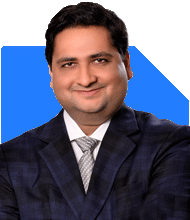Hardik Parikh | Answer |Ask -Follow
Tax, Mutual Fund Expert - Answered on May 11, 2023
He also holds an MBA degree from IIM-Indore.
Hardik, who began his career as an equity research analyst, founded his own advisory firm, Hardik Parikh Associates LLP, which provides a variety of financial services to clients.
He is committed to sharing his knowledge and helping others learn more about finance. He also speaks about valuation at different forums, such as study groups of the Western India Regional Council of Chartered Accountants.... more

Hello Hardik Ji, I am 52 year with a monthly income of around 75K-80K. I want to start the MUTUAL FUNDS / SIP investments for my retirement & my children Future who are in their twenties. Right now I am putting regular money in BANKS RD's / FD's only. Kindly advise / suggest how can i go ahead. Thanks & Regards, RV
I appreciate that you are thinking about your retirement and your children's future. As a financial advisor, I would be happy to help you start investing in mutual funds and SIPs. Before diving into specific suggestions, let's first understand your financial goals and risk appetite.
Given your age and monthly income, you should aim to diversify your investments for long-term wealth creation and financial stability. While RDs and FDs offer low risk and guaranteed returns, they may not be sufficient for higher returns and beating inflation in the long run. Mutual funds and SIPs can help you achieve better returns, provided you make well-informed decisions and stay invested for a long period.
Here are some steps to help you get started:
Define your goals: Identify the specific financial goals you want to achieve through your investments, such as your retirement corpus and your children's higher education or marriage expenses.
Assess your risk appetite: Determine your willingness and ability to take risks in your investments. As you have been investing in FDs and RDs, it seems that you prefer low-risk options. However, considering your age and goals, you may want to include some moderate to high-risk investments in your portfolio for better returns.
Diversify your portfolio: Invest in a mix of equity, debt, and hybrid mutual funds to spread the risk and optimize returns. You can consider investing in large-cap, mid-cap, and small-cap funds, balanced funds, and debt funds based on your risk appetite and goals.
Start with SIPs: Systematic Investment Plans (SIPs) allow you to invest a fixed amount regularly in a mutual fund, which helps in inculcating a disciplined savings habit and averaging out market volatility.
Consult a financial advisor: For personalized advice, you may want to consult a professional financial advisor who can help you select the right funds and create a tailored investment plan based on your goals, risk appetite, and investment horizon.
Remember, mutual fund investments are subject to market risks, and it's essential to stay informed and monitor your investments periodically. I hope this helps you get started on your journey to financial planning for your retirement and children's future.
Wishing you all the best, Rahul Ji!
Warm Regards,
Hardik
You may like to see similar questions and answers below
Omkeshwar Singh | Answer |Ask -Follow
Head, Rank MF - Answered on Jul 11, 2022
Ulhas Joshi |280 Answers |Ask -Follow
Mutual Fund Expert - Answered on Apr 18, 2023
Ramalingam Kalirajan |10893 Answers |Ask -Follow
Mutual Funds, Financial Planning Expert - Answered on Oct 26, 2023
Sanjeev Govila | Answer |Ask -Follow
Financial Planner - Answered on Jun 15, 2023
Ramalingam Kalirajan |10893 Answers |Ask -Follow
Mutual Funds, Financial Planning Expert - Answered on Jul 15, 2024
Nitin Narkhede |113 Answers |Ask -Follow
MF, PF Expert - Answered on Dec 15, 2025
Nitin Narkhede |113 Answers |Ask -Follow
MF, PF Expert - Answered on Dec 15, 2025
Ramalingam Kalirajan |10893 Answers |Ask -Follow
Mutual Funds, Financial Planning Expert - Answered on Dec 15, 2025
Ramalingam Kalirajan |10893 Answers |Ask -Follow
Mutual Funds, Financial Planning Expert - Answered on Dec 15, 2025
Radheshyam Zanwar |6746 Answers |Ask -Follow
MHT-CET, IIT-JEE, NEET-UG Expert - Answered on Dec 15, 2025
Ramalingam Kalirajan |10893 Answers |Ask -Follow
Mutual Funds, Financial Planning Expert - Answered on Dec 15, 2025
Ramalingam Kalirajan |10893 Answers |Ask -Follow
Mutual Funds, Financial Planning Expert - Answered on Dec 15, 2025
Ramalingam Kalirajan |10893 Answers |Ask -Follow
Mutual Funds, Financial Planning Expert - Answered on Dec 15, 2025
Samraat Jadhav |2508 Answers |Ask -Follow
Stock Market Expert - Answered on Dec 15, 2025
Ramalingam Kalirajan |10893 Answers |Ask -Follow
Mutual Funds, Financial Planning Expert - Answered on Dec 15, 2025





























